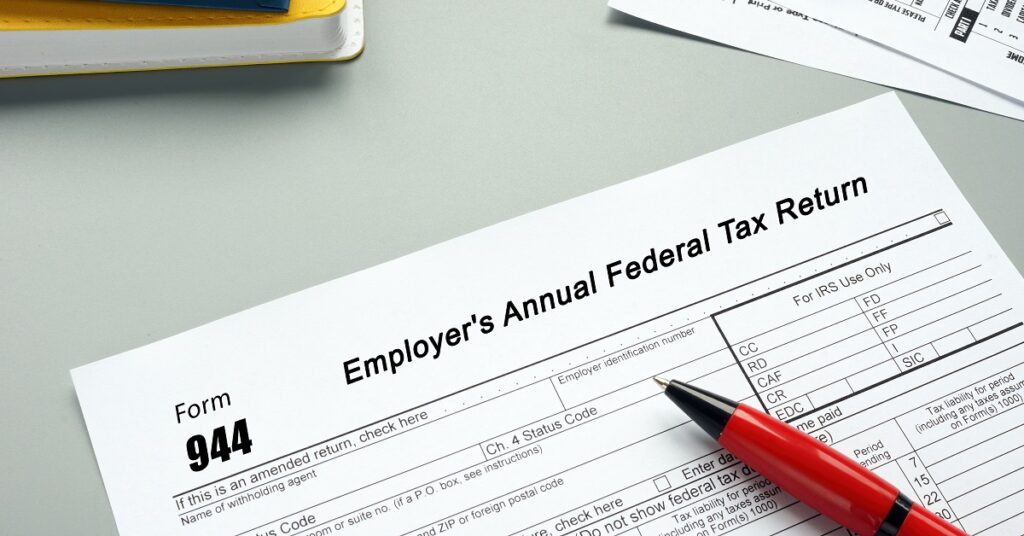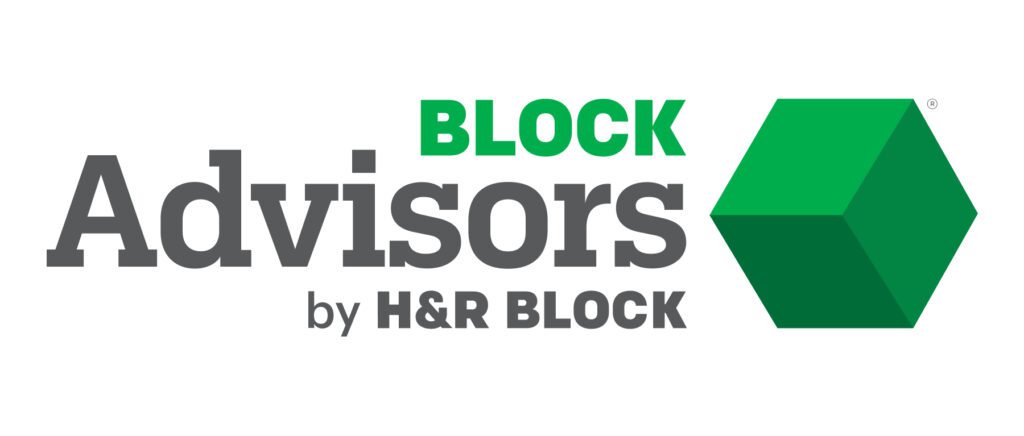Form 944: Definition, instructions, and who needs to file it
8 min read
May 14, 2025 • Block Advisors
If you’re a small business owner, you may have received a notice from the Internal Revenue Service (IRS) that says you must file IRS Form 944. Don’t be alarmed if you receive this notice – it’s standard practice for smaller businesses that must report their tax obligations. But what exactly is Form 944, and why does your small business need to file one?
Here are some things you should know about Form 944. Learn who needs to file it and read step-by-step instructions to help you file your return accurately and confidently.
What is IRS Form 944?

If your small business has employees, you must report income and payroll taxes that you withheld from their checks as part of your tax obligations.
IRS Form 944 is titled the “Employer’s Annual Federal Tax Return.” It is a tax form that reports the taxes you’ve withheld from your employees’ paychecks. These include federal income tax, social security tax, and Medicare tax. This IRS document also calculates and reports your Social Security and Medicare (FICA) tax liability as an employer.
Here’s a breakdown of everything you can report:
- Employee wages and tips
- Federal income tax withheld
- Employer and employee share of Social Security and Medicare taxes
- Adjustments to Social Security and Medicare wages and tips
- Small business tax credit for increasing research activities
Form 944 vs 941: What’s the difference?
Most employers are familiar with Form 941, Employer’s Quarterly Federal Tax Return. They must file it quarterly to meet IRS reporting requirements. So, if you’re an employer with a small business, you may wonder why you received a notice for Form 944 vs Form 941.
In 2007, the IRS introduced Form 944 to improve efficiency and decrease time spent by employers completing paperwork. It was created particularly for small businesses with fewer employees and, therefore, less tax liability. Form 944 is the annual equivalent of the quarterly Form 941. In other words, some small businesses must only file a 944 form once per year rather than filing a 941 form four times yearly.
You will receive Form 944 instead of Form 941 if you have an annual employment tax liability of no more than $1,000 and expect to pay $5,000 or less in total employee wages for the year. Employers will list the same information on both forms.
Who needs to file Form 944
Again, to be eligible to file this form, your small business must have $1,000 or less in total annual payroll tax liability. It’s important to note that the IRS must notify you in writing of your eligibility to file Form 944 instead of 941. Pay close attention to this notice because it will state whether your small business is required or eligible to file the tax form.
If you are required to file Form 944, you must file this tax form. You cannot file Form 941 unless you’ve requested and received permission from the IRS. However, if you’re only eligible and not required to file Form 944, you can continue to file Form 941 every quarter if you wish to do so. If you did not receive any notice from the IRS, you should file Form 941.
If you have not received an IRS notice that you are eligible but believe your employment tax liability meets the requirements, you can contact the IRS via mail or phone to request a change. This request must be made within the first month of the year, and if the IRS does change your filing requirements, you will be sent a written notice.
Tax expertise to fit your small business
File self-employed taxes with a professional today
Form 944 filing exemptions
Small businesses should be aware of some exceptions to filing requirements for this form. Even if your small business meets the lower tax liability requirement, you are not eligible if:
- You only employ household employees
- You only employ agricultural employees
Do I need to file a 944 if I have no employees?
Yes, even if you have no employees, if the IRS notified you, you must complete Form 944. In this scenario, you will fill out the form to the best of your ability, skipping over the parts that apply to withheld wages.
Where to find Form 944
You may wonder where to find the tax form if you have received notice that you’re required or eligible to file Form 944. Like other small business tax forms, you can find it on the IRS website.
File small business taxes on your own time
Get help from a live expert and AI Tax Assist
Form 944 instructions: How to file
Like with most business tax forms, there are different ways you can submit your completed 944 form. You can file it physically by printing a copy you either filled out on your computer or a blank copy you fill out by hand, then mail it. If you mail a paper copy, the IRS instructions specify the location to send it to, as this differs depending on your state and if you’re filing with a payment. You can also file electronically, which the IRS encourages. You can submit the form yourself using an IRS-approved software provider or with a tax professional, such as a Block Advisors small business certified tax pro, authorized to file on your behalf.
No matter how you submit your 944 form, the steps for filing are the same. There is an employer information section and five parts. We’ll outline those below —but you can always leave the paperwork to us—it’s why we’re here! Let our small business tax pros take care of your Form 944 so you can get back to doing what you love.
Top of Form 944: Basic business information
The top of the document requests your basic identifying information:
- Employer Identification Number (EIN)
- Name
- Trade name (if applicable)
- Address
Part 1
The first part of Form 944 is where you will report the total wages paid to your employees as well as the total amount of federal income tax withheld for the tax year. You’ll provide details about employee wages, tips, and other compensation.
In this section, you will also calculate Social Security and Medicare taxes. Lastly, by comparing your total deposits to your tax liability, you’ll determine if you owe the IRS or have a balance due.
Part 2
The second section of Form 944 is where you report your business’s deposit schedule and tax liability for the year. First, check whether line 9 in Part 1 is less than $2,500. If that value is less than $2,500, skip this section and go to Part 3. If it’s $2,500 or greater, enter your tax liability for each month.
Part 3
The third part asks if your business is closed or if you have stopped paying wages. If either applies to your small business, check the box and fill in the last date you paid employees. Otherwise, leave this section blank and move to Part 4.
Part 4
The fourth section asks if you want to grant the IRS permission to speak with a third-party designee. This could be an employee, tax preparer, CPA, or someone else you would like to allow the IRS to speak to on your business’s behalf. So, if you enlist the help of a tax pro at Block Advisors, for instance, you will indicate it here.
Part 5
The fifth and final part of Form 944 asks you to sign your name affirming that you’ve examined the return and believe it is accurate and complete. If you use a tax preparer, they fill in their information in the “Paid Preparer Use Only” area.
File Form 944 and make a payment, if necessary
Once you or your tax pro have reviewed the information you provided and signed off where necessary, the form is now complete! File the form either electronically or by mail by the deadline. If you must pay the IRS, you can mail Form 944-V along with Form 944 and a check or money order or pay your balance online.
“Form 944 is due by January 31st every year, regardless of your chosen filing method. If the date falls on a weekend or Federal holiday, the deadline moves to the next business day.”
IRS Form 944 deadlines and important due dates
The form is due by January 31st every year, regardless of your chosen filing method. If the date falls on a weekend or Federal holiday, the deadline moves to the next business day.
Penalties for late filing
If you fail to file IRS Form 944 by the deadline, you may incur a 5% penalty on the tax owed for each month the return is late. If you pay late or do not pay the full amount owed, you may be charged 2-15% of the unpaid tax, determined by the number of days the amount remains unpaid.
Help with submitting Form 944 for your small business
Form 944 is an important tax form for small business owners to understand and use correctly. Whether it’s the calculations or understanding your eligibility, it’s reasonable if you feel overwhelmed by this (and other) tax forms.
Get back to doing what you love and let our experts lighten your load, in person or virtually, year-round – as always – backed up by the Block Advisors guarantees. Our taxes, bookkeeping, payroll, incorporation, and beneficial owner reporting services are designed with small business owners like you in mind.
Speak with a certified small business tax pro today to get help with tax calculations, filing support, or formula assistance.





